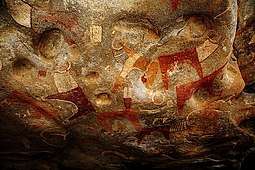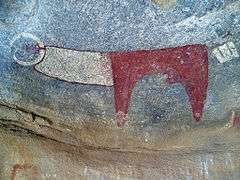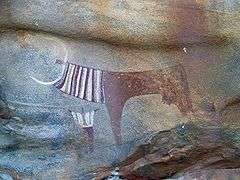Laas Geel
| Laas Geel | |
|---|---|
 | |
| Location | Hargeisa, Somaliland |
| Access | Public |
Laas Geel (Somali: Laas Geel), also spelled Laas Gaal, are cave formations on the rural outskirts of Hargeisa, Somalia (situated in the Woqooyi Galbeed region of the self-declared but internationally unrecognised Republic of Somaliland). They contain some of the earliest known cave paintings in the Horn of Africa. Laas Geel's rock art is estimated to date to somewhere between 9,000 and 3,000 years BC.
Discovery

During November and December 2002, an archaeological survey was carried out in Somalia by a French team of researchers. The expedition's objective was to search for rock shelters and caves, that contain archaeological sediments and infills in order to document the historical period when production economy appeared in this part of the Horn of Africa (circa 5,000 to 2,000 years BC). During the course of the survey, the excavation team discovered the Laas Geel cave paintings, that encompass an area of ten rock alcoves (caves).[1] In an excellent state of preservation, the rock art depicts wild animals and decorated cattle (cows and bulls). They also feature herders, who are believed to be the creators of the paintings.[2] Laas Geel's rock art is executed in the same distinctive Ethiopian-Arabian style as the Dhambalin and Karinhegane cave paintings that are also situated in Somaliland.[3]
Although the Laas Geel rock art had been known to the area's inhabitants for centuries, its existence only came to international attention after the 2002 discovery. In November 2003, a mission returned to Laas Geel and a team of experts undertook a detailed study of the paintings in their prehistoric context.
Somalia, in general, is home to numerous such archaeological sites and megalithic structures, with similar rock art found at Haadh, Gudmo Biyo Cas, Dhambalin, Dhagah Maroodi and numerous other sites, while ancient edifices are, among others, found at Sheikh, Aynabo, Aw-Barkhadle, Ancient Amud, Heis, Maydh, Haylan, Qa’ableh, Qombo'ul and El Ayo.[4] However, many of these old structures have yet to be properly explored, a process which would help shed further light on local history and facilitate their preservation for posterity.[5]
Description
The Laas Geel cave paintings are thought to be some of the most vivid rock art in Africa. Among other things, they depict cattle in ceremonial robes accompanied by humans, who are believed to have been inhabitants of the region. The necks of the cattle are embellished with a kind of plastron. Some of the cattle are also portrayed wearing decorative robes. Besides long-horned cattle, the rock art also shows an image of a domesticated dog, several paintings of Canidae as well as a giraffe.[1] The site is excellently preserved due to the location of the paintings which are covered by the granite overhangs.[6]
Gallery
 Depiction of a ceremonial cow
Depiction of a ceremonial cow A human and cow
A human and cow A herd of cows
A herd of cows A single cow
A single cow One of the alcoves at Laas Geel
One of the alcoves at Laas Geel Various rock art
Various rock art- Various other rock art
References
- 1 2 The Journal of African Archeology Volume 1.2 (2003) Chapter 3
- ↑ Bakano, Otto (April 24, 2011). "Grotto galleries show early Somali life". AFP. Archived from the original on 30 April 2011. Retrieved 11 May 2013.
- ↑ Istituto universitario orientale (Naples, Italy) (1992). Annali: Supplemento, Issues 70-73. Istituto orientale di Napoli. p. 57.
- ↑ Mire, Sada (2015-04-14). "Mapping the Archaeology of Somalia: Religion, Art, Script, Time, Urbanism, Trade and Empire". African Archaeological Review. 32 (1): 111–136. doi:10.1007/s10437-015-9184-9. ISSN 0263-0338.
- ↑ Michael Hodd, East African Handbook, (Trade & Travel Publications: 1994), p.640.
- ↑ "Photographs of Laas Geel, February 2015". Independent Travellers. independent-travellers.com. Retrieved July 15, 2017.
External links
Coordinates: 9°46′51″N 44°26′37″E / 9.780911°N 44.443642°E